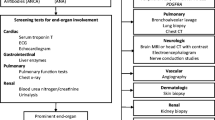Abstract
The role of eosinophilia in connective tissue diseases and the relationship between symptoms of rheumatic disease and eosinophilia have not been clearly established. The purpose of the present study was to explore the prevalence of eosinophilia in rheumatologic disease and determine its relationship to the symptoms. One thousand patients who applied to our rheumatology outpatient clinic between 2001 and 2002 were prospectively studied. The upper limit of normal blood eosinophil numbers was determined as 500 cells/µl of blood. A detailed history was obtained from all patients and careful physical examination was done. A negative correlation was observed between eosinophilia and dryness of the mouth, vitiligo, and fatigue (P<0.05). Nonsteroidal anti-inflammatory drug usage correlated positively with eosinophilia, which was also statistically meaningful (P<0.05). Twenty-six of our patients with fibromyalgia (n=293), three of our subjects with rheumatoid arthritis who were using methotrexate (n=182), 15 of whom who were not on methotrexate therapy, and one of the 26 with vasculitis had eosinophilia, which was not statistically significant (P>0.05). None of the patients with scleroderma (n=12) had eosinophilia. Eleven of the patients with gout had eosinophilia, and only one of them was using allopurinol. We conclude that eosinophilia can be seen in various rheumatologic conditions but, as corticosteroids are one of the most common medications used in collagen tissue diseases, the eosinophil numbers found may be lower than expected and eosinophilia may be more frequent than reported.
Similar content being viewed by others
References
Rytomaa T (1960) Organ distribution and histochemical properties of eosinophil granulocytes in the rat. Act Pathol Microbiol Scand 50:1
Gleich GJ, Adolphson CR, Leiferman KM (1993) The biology of the eosinophilic leukocyte. Annu Rev Med 44:85
Gleich GJ, Adolphson CR, Leiferman KM (1992) Eosinophils. In: Gallin JI, Goldstein IM, Snyderman R (eds) Inflammation: basic principles and clinical correlates, 2nd edn. Raven, New York, p 663
Bainton DF (1992) Developmental biology of neutrophils and eosinophils. In: Gallin J, Goldstein IM, Snyderman R (eds) Inflammation: basic principles and clinical correlates, 2nd edn. Raven, New York, p 303
Weller PF (1994) Eosinophils: structure and functions. Curr Opin Immunol 6:85
Gaglani B, Borish L, Bartelson BL, Buchmeier A, Keller L, Nelson HS (1997) Nasal immunotherapy in weed-induced allergic rhinitis. Ann Allergy Asthma Immunol 79:259–265
Slunt JB, Taketomi EA, Woodfolk JA, Hayden ML, Platts-Mills TA (1996) The immune response to Trichophyton tonsurans: distinct T cell cytokine profiles to a single protein among subjects with immediate and delayed hypersensitivity. J Immunol 157:5192-5197
Takatsu K (1992) Interleukin-5. Curr Opin Immunol 4:299–306
Ikagawa S, Matsushita S, Chen YZ, Ishikawa T, Nishimura Y (1996) Single amino acid substitutions on a Japanese cedar pollen allergen (cry j 1)-derived peptide induced alterations in human T cell responses and T cell receptor antagonism. J Allergy Clin Immunol 97:53–64
Bochner BS, Klunk DA, Sterbinsky SA, Coffman RL, Schleimer RP (1995) IL-13 selectively induces vascular cell adhesion molecule-1 expression in human endothelial cells. J Immunol 154:799–803
Krug N, Madden J, Redington AE, Lackie P, Djukanovic R, Schauer U, Holgate ST, Frew AJ, Howarth PH (1996) T-cell cytokine profile evaluated at the single cell level in BAL and blood in allergic asthma. Am J Respir Cell Mol Biol 14:319–326
Bonfield TL, Konstan MW, Burfeind P, Panuska JR, Hilliard JB, Berger M (1995) Normal bronchial epithelial cells constitutively produce the anti-inflammatory cytokine interleukin-10, which is downregulated in cystic fibrosis. Am J Respir Cell Mol Biol 13:257–261
Murray JK, Laxer RM (2002) Scleroderma in children and adolescents. Rheum Dis Clin North Am 28:603–624
Bodemer C, Belon M, Hamel-Teillac D, Amoric JC, Fraitag S, Prieur AM, De Prost Y (1999) Scleroderma in children: a retrospective study of 70 cases [French]. Ann Dermatol Venereol 126:691–694
Falanga V, Medsger TA Jr (1987) Frequency, levels, and significance of blood eosinophilia in systemic sclerosis, localized scleroderma, and eosinophilic fasciitis. J Am Acad Dermatol 17:648–656
McCartney-Francis NL, Wahl S (1995) Transforming growth factor beta: a matter of life and death. J Leuk Biol 55:401–409
Trentham DE, Dynesius-Trentham RA, Orav EJ, Combitchi D, Lorenzo C, Sewell KL, Hafler DA, Weiner HL (1993) Effects of oral administration of type II collagen on rheumatoid arthritis. Science 261:1727–1729
Schwartz RH (1996) Models of T cell anergy: is there a common molecular mechanism? J Exp Med 184:1–8
Lie JT, Michet CJ Jr (1988) Thromboangiitis obliterans with eosinophilia (Buerger’s disease) of the temporal arteries. Hum Pathol 19:598
Van de Laar MJ, van der Korst JK (1991) Rheumatoid arthritis, food, and allergy. Semin Arthritis Rheum 21:12–23
Fox R, van Breemen J (1934) Chronic rheumatism: causation and treatment. Churchill, London, p 155
Short CL, Bauer W, Reynolds WE (1957) Rheumatoid arthritis. Harvard University Press, Cambridge, pp 354–356
Sylvester RA, Pinals RS (1970) Eosinophilia in rheumatoid arthritis. Ann Allergy 45:234–247
Chan YC, Tay YK, Ng SK (2002) Allopurinol hypersensitivity syndrome and acute myocardial infarction two case reports. Ann Acad Med Singapore 31:231–233
Khoo BP, Leow YH (2000) A review of inpatients with adverse drug reactions to allopurinol. Singapore Med J 41:156–160
Pluim HJ, van Deuren M, Wetzels JF (1998) The allopurinol hypersensitivity syndrome. Neth J Med 52:107–110
Singer JZ, Wallace SL (1986) The allopurinol hypersensitivity syndrome. Unnecessary morbidity and mortality. Arthritis Rheum 29:82–87
Author information
Authors and Affiliations
Corresponding author
Rights and permissions
About this article
Cite this article
Kargılı, A., Bavbek, N., Kaya, A. et al. Eosinophilia in rheumatologic diseases: a prospective study of 1000 cases. Rheumatol Int 24, 321–324 (2004). https://doi.org/10.1007/s00296-004-0469-6
Received:
Accepted:
Published:
Issue Date:
DOI: https://doi.org/10.1007/s00296-004-0469-6




